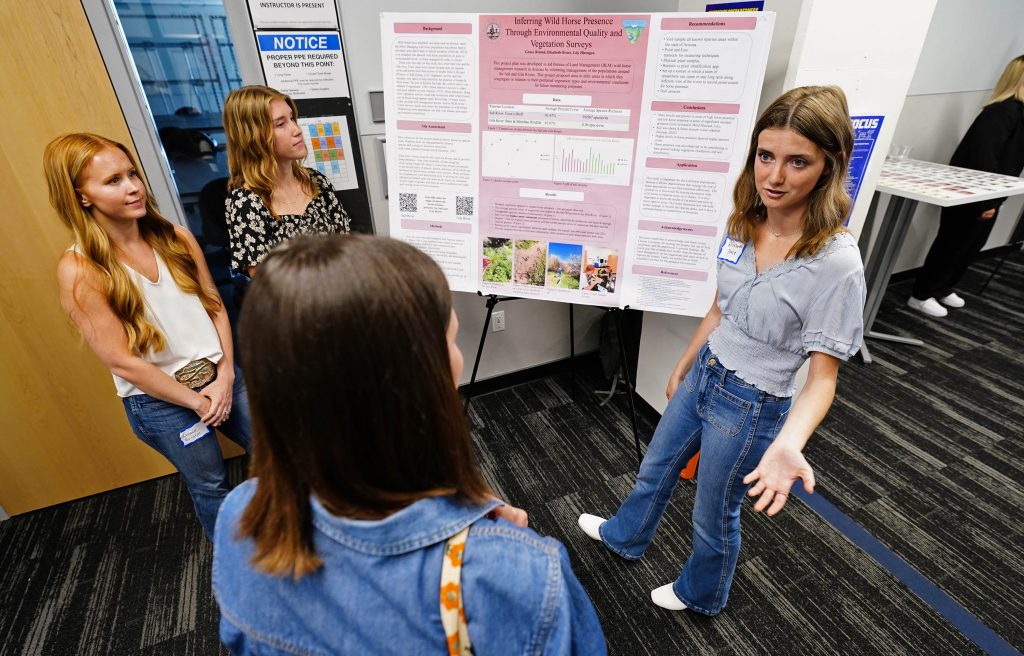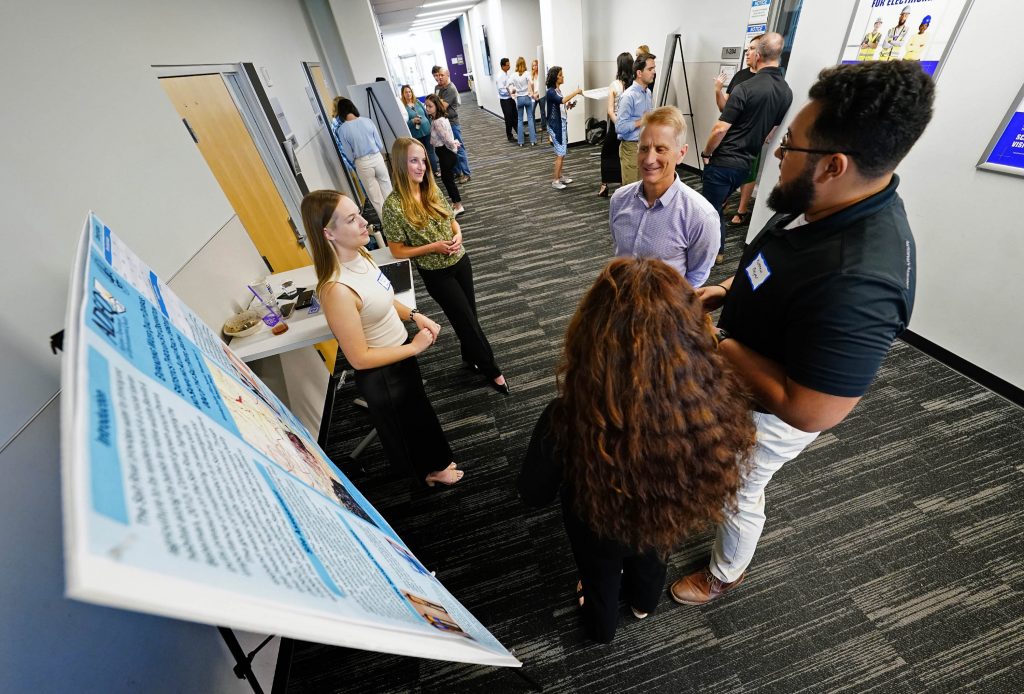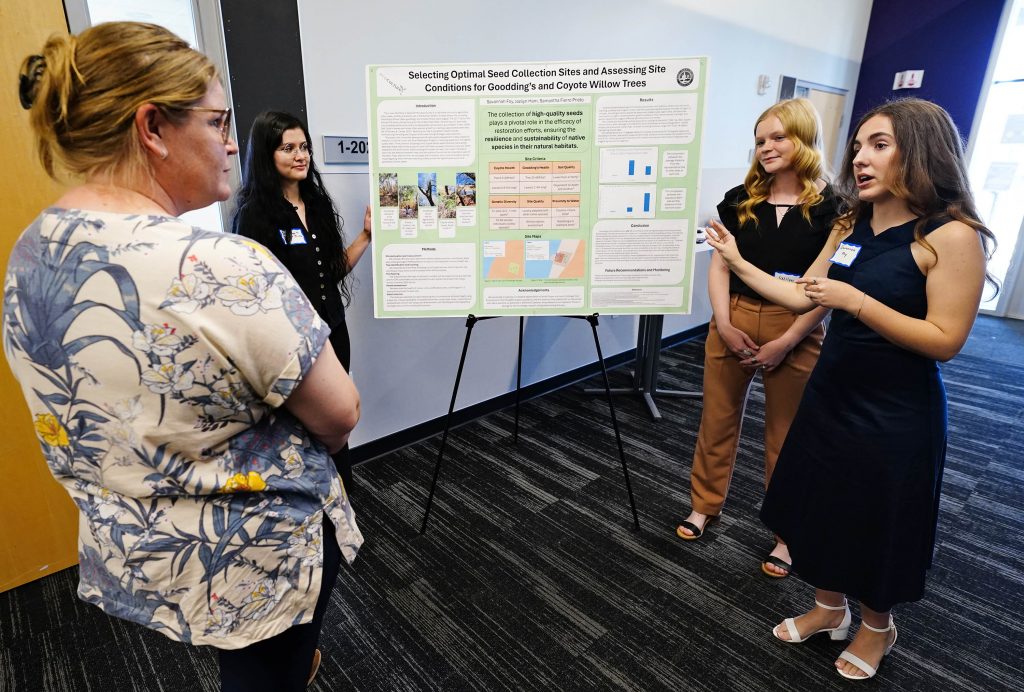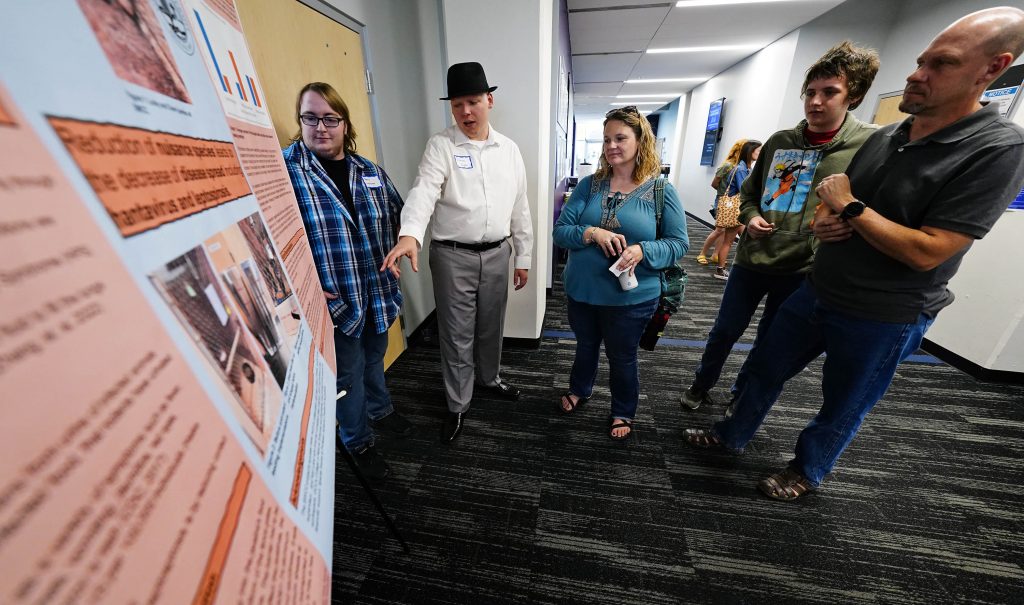
Photos by Ralph Freso
People aren’t the only ones who hang out by the water cooler. As it turns out, horses do, too.
That was what a group of Grand Canyon University biological science students discovered, proposing some popular horse hangouts alongside the lower Salt and Gila rivers to the Bureau of Land Management.
“We were trying to locate where they would congregate along the rivers,” said Elisabeth Bruce, who presented her end-of-college capstone project with teammates Grace Bristol and Lily Hirengen called “Inferring Wild Horse Presence Through Environmental Quality and Vegetation Surveys.”
They were one of six groups presenting projects at the small-but-mighty Biological and Environmental Sciences Capstone Showcase on Monday afternoon in the Engineering Building.
Bruce, Bristol and Hirengen’s goal was to help the BLM in their management of wild horses. According to the team’s research, wild horses have been a problem because of the sheer number of them in Arizona, where there is a lack of natural predators. That low predation has allowed the population to soar to unsustainable levels.
The trio of students assessed two riparian zones, or areas along a riverbank, that horses have been known to inhabit in the past. They wanted to see if horses were still likely to congregate at those sites by assessing the vegetation there.

Wild mustard, for example, is toxic to horses, and its presence would mean low horse presence. Bruce, Bristol and Hirengen also took soil samples to see if the soil was more alkaline at those sites, since horse manure increases the soil’s alkalinity.
By identifying high-likelihood horse congregation sites, they’re helping the BLM “be more effective with their resources so they’re not trying to find these horses in such big areas. We can really bring it (the search area for wild horses) down to smaller areas and be more specific on where they’d be found,” Bruce said.
She added, “This would be a way to efficiently track where the horses are going based off of what kind of plants they might be eating or how they’re affecting the environment in those areas.”
Just last spring, the first students to complete the capstone course – and to graduate from GCU’s Bachelor of Science in Biological Sciences program – presented their work.
Monday’s event was the third such showcase for those students and fellow students in the environmental sciences.
What gives the capstone its bite is that students don’t just create silo projects. They team up with a specific client, such as the BLM, Arizona Game and Fish Department or Arizona Department of Environmental Quality.
Together, the students and the organizations they’re partnering with develop a project plan and proof of concept for either an improvement or an area of need.
“The goal of this (capstone) course is to take what you’ve learned and find a practical application for it in an area of your interest,” said GCU biological sciences instructor Adrienne Crawford, who mentored the students in the showcase, as did Berenise Charlton, the University’s environmental sciences assistant professor. “Every year, we have been very fortunate. All the clients that the students reached out to have been very welcoming in embracing our students and getting them on the right path.”
Students during the capstone process also are building relationships with biologists, environmental scientists and the like in the fields they’re studying, Crawford said, which means greater chances for internships at those organizations or even jobs.
Another team at the showcase pitched their project, “Selecting Optimal Seed Collection Sites and Assessing Site Conditions for Goodding’s and Coyote Willow Trees.”

It’s a long name for a simple project: to find the best seed collection sites so that the team’s partner, Ecoculture, and the project it developed, the Lower Salt River Restoration Project, can revive the river’s ecosystem health after the devastating 2017 Cactus Fire burned more than 800 acres of riparian habitat.
Riparian areas represent just .4% land cover in Arizona and play a vital role in the ecosystem of the arid Southwest. But they’re in danger because of human development, invasive species and wildfire, like the Cactus Fire.
The Lower Salt River Restoration Project aims to reduce invasive species, such as the saltcedar, whose presence was paved by the wildfire. The leaves of the saltcedar create a salty blanket on the ground that hinders the growth of other species.
The project also aims to restore the Goodding’s and coyote willows that thrived there before the fire.
“We did a lot of this work on our own,” said biological sciences major Savannah Foy, who worked on the capstone with Jazilyn Ham and Samantha Fierro Prieto. “Collecting data to create our site criteria was a lot of research. We created a literature review using peer-reviewed sources to back up the criteria we were giving them, and then we actually went out, the three of us, to collect the data.”
The trio assessed three sites they chose based on accessibility by foot. They wanted to find the sites with the most optimal conditions for seed collecting and gave their data and site recommendations to Ecoculture. They also created site criteria the organization could use for future site assessments.
The team looked at soil temperature, tree health (cracked trunks? visible roots?) and recorded the average distance between trees, which the team says indicates the most genetically diverse population.
Jacob Draper and Justin Eddinger, part of the Lower Salt River Restoration Project team, helped the GCU students by suggesting assessment sites and helping them identify invasive species. Ecoculture will take the seeds they gather to Northern Arizona University, where they'll be grown for a year before being transported and planted back along the river.
One off-river project was students pairing with the Southwest Wildlife Conservation Center in Scottsdale to reduce nuisance species and disease at the facility.

Students discovered that common house mice are a big problem at the center. The mice urinate and defecate on food, which puts the resident animals in danger of developing diseases, particularly leptospirosis. The presence of mice also puts staff in danger of contracting hantavirus pulmonary syndrome.
“In the past, they’ve had a leptospirosis outbreak,” said Bethany Lanier, who worked on the project with Sofia Haburchak, James Lafollette and Joshua Eager. Several resident animals died as a result.
Students worked at the in-and-out barn, where javelinas are housed, to try to reduce the mice presence. They installed a barrier along the bottom of the fence gates, fashioning large sheets of aluminum in GCU's engineering metal shop to act as that barrier. They also got the javelinas’ food off the ground – and away from the reach of mice – by attaching food troughs to the fence using carabiners.
Eager said the team encountered one unexpected result: “The javelinas saw their food bowl as a toy and in five minutes, they bumped it with their heads and knocked the food out,” he said. “We’re hoping they’ll learn it’s their food. But we’re also suggesting putting something heavy in the food bowl to keep it down.”
A bar chart on the team’s poster showed the number of mice observed over three days. They saw fewer mice one day, more the next and a right-on-average count the last day.
“We’re continuing to get data from them, and we’re hoping to continue to see improvement. We wish we had more weeks,” Eager said of the study. “As you can see, we’re really excited.”
Manager of Internal Communications Lana Sweeten-Shults can be reached at [email protected] or at 602-639-7901.
Related content:
GCU News: Environmental, conservation projects unearthed at showcase
GCU News: She blinded them with science at Fan Fusion’s Discovery Lab
GCU News: Class outside? Students, state biologists are game















